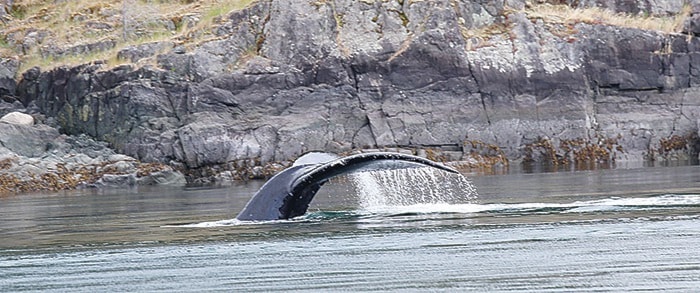The Marine Education and Research Society (MERS) has launched a new awareness campaign in an attempt to keep both boaters and our coastal wildlife friends safe.
MERS launched its new “See a Blow? Go Slow!” campaign in response to a rise in humpback whale sightings along the coast. They say whales and other marine mammals can surface suddenly and unpredictably and so are reminding boaters of a few points to remember out on the water.
Watch the water. Always be on the lookout not only for actual whale blows, but also for other signals that may signal the presence of whales, such as large groupings of sea birds. Large aggregations of birds often mean that there is a lot of feed in an area and therefore an enhanced chance of whale presence.
Watch for boats flying triangular yellow pennants with black letters and numbers, or a white flag with a yellow and red circle and a whale tail. The triangular pennants are flown by operators working under a Fisheries and Oceans licence to undertake research on marine mammals, which may involve approaching the animals approaching marine mammals for research purposes.
Know the areas traditionally dense in whales. MERS has created a map of known whale densities around Campbell River and Quadra Island. Areas highlighted on the map include between Campbell River and Quadra Island, between Bloedel and Quadra and up near Rock Bay.
When whales are actually sighted, MERS is reminding boaters of the 100-metre rule. Boaters are not to approach whales or position their boats within 100m of a whale at any time, and if they find themselves within 100m of a whale for any reason, to immediately place engines in neutral or turn them off altogether until they are outside that range. When within 400m of a whale, boaters are asked to slow to less than seven knots and avoid abrupt course changes.
MERS Is also saying that with increasing numbers of sightings comes increased risk of entanglement. Research MERS has conducted suggests that possibly as many as half of B.C. humpback whales have been entangled at some point in their lives.
If you encounter a humpback that is entangled, contact the Department of Fisheries and Oceans incident line (1-800-465-4336) immediately with the location of the whale, and stay with the whale (at a distance) until trained help arrives or another boat takes on the tracking of the animal.
